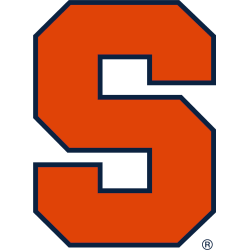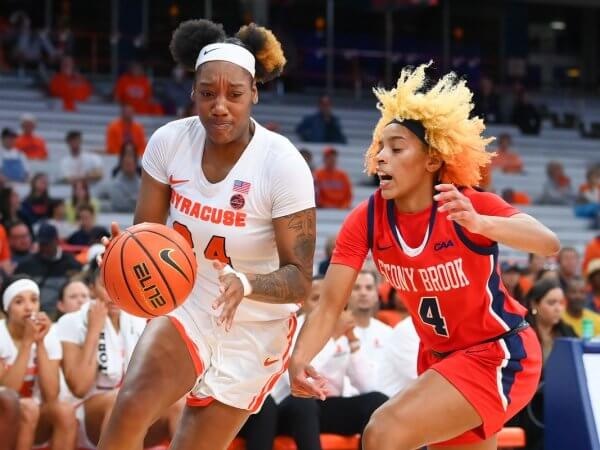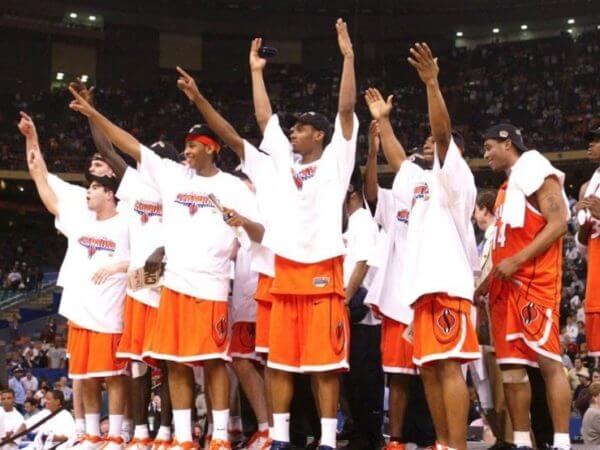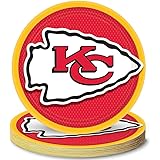
College Sports Established
1889
Location
Syracuse, New York
College Name
Syracuse University
Collegiate History
1973 - Present / NCAA Division 1
1921 - 1973 / University Division of the NCAA
1907 - 1921 / Athletic Association of the United States
Conference History
2013 - Present / ACC
1979 - 2013 / Big East Conference
1889 - 1978 / Independent
Nickname
Orange - The Syracuse Orange is a powerhouse in NCAA athletics, with a storied history that dates back to the late 19th century. As one of the most successful teams in college sports, it's no surprise that they have an equally iconic nickname. But where did this iconic moniker come from? Look at how “Orange” became synonymous with Syracuse University Athletics!
The official story is that “Orange” was chosen as the school color by Dr. Archibald Lansing Collins and Mrs. Olive Bronson Strong after they visited Cornell University in the 1889-1890 academic year, where they saw Cornell students wearing orange ribbons and scarves during sporting events – which were said to be inspired by Princeton who had adopted orange as their school color some years prior due to its symbolic meanings of strength, power, courage, and success; all qualities associated with great universities like Syracuse! The name has stuck ever since then - although there has been speculation over other possible origins, such as honoring William DeWitt Hyde (the first president of SU) or because it was thought at one point oranges grew on campus trees (they don't).
Regardless of why "Syracuse Orange" came about, though – we can all agree it's become an integral part of what makes up our beloved university today! It represents excellence on the field and pride off-field for alumni everywhere who proudly sport apparel adorned with this timeless logo & mascot every day around town & beyond - showing just how much everyone loves being part of something bigger than themselves: Go 'Cuse!!
NCAA Championships
Baseball 0
Men's Basketball 1
2003, 1926, 1918
Women's Basketball 0
Football 1
1959
Soccer 0
- 1956
- 1959
- 1983
- 1988
- 2003
- 2013
-
Syracuse Great – Jim Brown
As a sophomore at Syracuse University (1954), Brown was the second-leading rusher on the team. As a junior, he rushed for 666 yards (5.2 per carry). In his senior year in 1956, Brown was a consensus first-team All-American. He finished fifth in the Heisman Trophy voting and set school records for highest season rush average (6.2) and most rushing touchdowns ... -
Syracuse’s 1959 National Championship
1959: The football team wins its second and most recent national championship under coach Ben Schwartzwalder and features running back Ernie Davis. -
Syracuse Orange men’s basketball team reaches the Final Four
In 1983: The men’s basketball team reaches the Final Four for the first time under coach Jim Boeheim and features forward Leo Rautins. -
Syracuse Orange women’s basketball team reaches NCAA
In 1988: The women’s basketball team reaches the NCAA tournament for the first time under coach Barbara Jacobs and features guard Julie McBride. -
NCAA Basketball Champs for Orange in 2003
The 2002–03 Syracuse Orangemen basketball team represented Syracuse University in NCAA men’s basketball competition in the 2002–03 Division I season. The head coach was Jim Boeheim, serving for his 27th year. The team played its home games at the Carrier Dome in Syracuse, New York. The team finished with a 30–5 (13–3) record while capturing its first modern-era NCAA Championship. ... -
Orange Football team joins the ACC conference and reaches the Texas Bowl
In 2013: The football team joins the ACC conference and reaches the Texas Bowl, where it defeats Minnesota 21-17.
To qualify as the greatest player for this team, the player must have played one season for this team. If not, we will remove the player.
* verifies that player has played for this team as an added player by a fan.
History of the Orange
The Syracuse Orange is a college sports team that has played in the NCAA since its inception. The team has had a long and successful history of winning championships, making it one of the most decorated teams in all collegiate sports. From their first national championship win in 1959 to their most recent title victory in 2016, the Orange have consistently proven themselves as an elite program year after year.
One of the main reasons for this success is legendary head coach Jim Boeheim who took over back in 1976 and still leads today’s squad. He holds an impressive 903-390 record with 33 NCAA tournament appearances during his tenure, including four Final Four berths and one National Championship win against Kansas back on April 5th, 2003, at New Orleans Superdome. His leadership and some great players like Carmelo Anthony, Derrick Coleman, John Wallace, Sherman Douglas, and Hakim Warrick helped Syracuse become a basketball powerhouse throughout his time there.
In addition to basketball success, the school also competes across many other varsity sporting events such as Football (FBS), Baseball (Division I), Soccer (Division I), Lacrosse( Division 1 ) Track & Field( Division 1 ), Tennis ( Division1). All these programs are led by strong coaches who continually strive for excellence each season while providing student-athletes with valuable experience, both on-field/court-off-court learning experiences through academics & life skills development opportunities provided by university resources. As you can see from past results, the Syracuse orange athletics program has achieved remarkable success, which makes them one top Universities when it comes to college sports competitions.
































